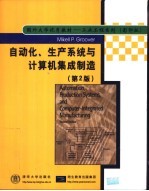

自动化、生产系统与计算机集成制造 英文版PDF电子书下载
- 电子书积分:23 积分如何计算积分?
- 作 者:Mikell P.Groover著
- 出 版 社:北京:清华大学出版社
- 出版年份:2002
- ISBN:7302054843
- 页数:856 页
Chapter 1 INTRODUCTION 1
1.1 Production System Facilities 2
1.2 Manufacturing Support Systems 7
1.3 Automation in Production Systems 9
1.4 Manual Labor in Production Systems 14
1.5 Automation Principles and Strategies 17
1.6 Organization of the Book 21
Chapter 2 MANUFACTURING OPERATIONS 24
2.1 Manufacturing Industries and Products 28
2.2 Manufacturing Operations 31
2.3 Product/Production Relationships 35
2.4 Production Concepts and Mathematical Models 40
2.5 Costs of Manufacturing Operations 48
PART Ⅰ: AUTOMATION AND CONTROL TECHNOLOGIES 61
Chapter 3 INTRODUCTION TO AUTOMATION 61
3.1 Basic Elements of an Automated System 63
3.2 Advanced Automation Functions 71
3.3 Levels of Automation 76
Chapter 4 INDUSTRIAL CONTROL SYSTEMS 79
4.1 Process Industries versus Discrete Manufacturing Industries 80
4.2 Continuous versus Discrete Control 82
4.3 Computer Process Control 88
4.4 Forms of Computer Process Control 96
Chapter 5 SENSORS,ACTUATORS,AND OTHER CONTROL SYSTEM COMPONENTS 107
5.1 Sensors 108
5.2 Actuators 111
5.3 Analog-to-Digital Conversion 112
5.4 Digital-to-Analog Conversion 115
5.5 Input/Output Devices for Discrete Data 117
Chapter 6 NUMERICAL CONTROL 120
6.1 Fundamentals of NC Technology 122
6.2 Computer Numerical Control 128
6.3 DNC 134
6.4 Applications of Numerical Control 137
6.5 NC Part Programming 145
6.6 Engineering Analysis of NC Positioning Systems 179
Chapter 6 APPENDIX:APT WORD DEFINITIONS 196
Chapter 7 INDUSTRIAL ROBOTICS 210
7.1 Robot Anatomy and Related Attributes 212
7.2 Robot Control Systems 218
7.3 End Effectors 220
7.4 Sensors in Robotics 222
7.5 Industrial Robot Applications 222
7.6 Robot Programming 230
7.7 Engineering Analysis of Industrial Robots 240
Chapter 8 DISCRETE CONTROL USING PROGRAMMABLE LOGIC CONTROLLERS AND PERSONAL COMPUTERS 257
8.1 Discrete Process Control 257
8.2 Ladder Logic Diagrams 264
8.3 Programmable Logic Controllers 268
8.4 Personal Computers Using Soft Logic 275
Part Ⅱ: MATERIAL HANDLING AND IDENTIFICATION TECHNOLOGIES 281
Chapter 9 INTRODUCTION TO MATERIAL HANDLING 281
9.1 Overview of Material Handling Equipment 282
9.2 Considerations in Material Handling System Design 285
9.3 The 10 Principles of Material Handling 288
Chapter 10 MATERIAL TRANSPORT SYSTEMS 292
10.1 Industrial Trucks 293
10.2 Automated Guided Vehicle Systems 295
10.3 Monorails and Other Rail Guided Vehicles 302
10.4 Conveyor Systems 303
10.5 Cranes and Hoists 309
10.6 Analysis of Material Transport Systems 311
Chapter 11 STORAGE SYSTEMS 328
11.1 Storage System Performance 329
11.2 Storage Location Strategies 331
11.3 Conventional Storage Methods and Equipment 332
11.4 Automated Storage Systems 335
11.5 Engineering Analysis of Storage Systems 344
Chapter 12 AUTOMATIC DATA CAPTURE 357
12.1 Overview of Automatic Identification Methods 358
12.2 Bar Code Technology 361
12.3 Other ADC Technologies 370
PART Ⅲ:MANUFACTURING SYSTEMS 375
Chapter 13 INRODUCTION TO MANUFACTURING SYSTEMS 375
13.1 Components of a Manufacturing System 376
13.2 Classification of Manufacturing Systems 381
13.3 Overview of the Classification Scheme 388
13.4 Manufacturing Progress Functions (Learning Curves) 392
Chapter 14 SINGLE STATION MANUFACTURING CELLS 397
14.1 Single Station Manned Workstations 398
14.2 Single Station Automated Cells 399
14.3 Applications 404
14.4 Analysis of Single Station Cells 409
Chapter 15 GROUP TECHNOLOGY AND CELLULAR MANUFACTURING 420
15.1 Part Families 422
15.2 Parts Classification and Coding 425
15.3 Production Flow Analysis 431
15.4 Cellular Manufacturing 434
15.5 Application Considerations in Group Technology 439
15.6 Quantitative Analysis in Cellular Manufacturing 442
Chapter 16 FLEXIBLE MANUFACTURING SYSTEMS 460
16.1 What is an FMS? 462
16.2 FMS Components 469
16.3 FMS Applications and Benefits 480
16.4 FMS Planning and Implementation Issues 485
16.5 Quantitative Analysis of Flexible Manufacturing Systems 487
Chapter 17 MANUAL ASSEMBLY LINES 514
17.1 Fundamentals of Manual Assembly Lines 516
17.2 Alternative Assembly Systems 523
17.3 Design for Assembly 524
17.4 Analysis of Single Model Assembly Lines 525
17.5 Line Balancing Algorithms 534
17.6 Mixed Model Assembly Lines 540
17.7 Other Considerations in Assembly Line Design 552
18.1 Fundamentals of Automated Production Lines 565
Chapter 18 TRANSFER LINES AND SIMILAR AUTOMATED MANUFACTURING SYSTEMS 566
18.2 Applications of Automated Production Lines 575
18.3 Analysis of Transfer Lines with No Internal Storage 579
18.4 Analysis of Transfer Lines with Storage Buffers 587
Chapter 19 AUTOMATED ASSEMBLY SYSTEMS 601
19.1 Fundamentals of Automated Assembly Systems 602
19.2 Design for Automated Assembly 606
19.3 Quantitative Analysis of Assembly Systems 610
PART Ⅳ:QUALITY CONTROL SYSTEMS 631
Chapter 20 INTRODUCTION TO QUALITY ASSURANCE 631
20.1 Quality Defined 633
20.2 Traditional and Modern Quality Control 635
20.3 Taguchi Methods in Quality Engineering 638
20.4 ISO 9000 648
Chapter 21 STATISTICAL PROCESS CONTROL 654
21.1 Process Variability and Process Capability 655
21.2 Control Charts 658
21.3 Other SPC Tools 667
21.4 Implementing Statistical Process Control 672
Chapter 22 INSPECTION PRINCIPLES AND PRACTICES 681
22.1 Inspection Fundamentals 682
- 《女丹仙道:道教女子内丹养生修炼秘籍 下》董沛文著 2012
- 《计算机网络与通信基础》谢雨飞,田启川编著 2019
- 《大学计算机实验指导及习题解答》曹成志,宋长龙 2019
- 《卓有成效的管理者 中英文双语版》(美)彼得·德鲁克许是祥译;那国毅审校 2019
- 《计算机辅助平面设计》吴轶博主编 2019
- 《计算机组成原理解题参考 第7版》张基温 2017
- 《云计算节能与资源调度》彭俊杰主编 2019
- 《Helmholtz方程的步进计算方法研究》李鹏著 2019
- 《民国时期医药卫生文献集成 37》路丽明编 2019
- 《AutoCAD 2018自学视频教程 标准版 中文版》CAD/CAM/CAE技术联盟 2019
- 《中风偏瘫 脑萎缩 痴呆 最新治疗原则与方法》孙作东著 2004
- 《水面舰艇编队作战运筹分析》谭安胜著 2009
- 《王蒙文集 新版 35 评点《红楼梦》 上》王蒙著 2020
- 《TED说话的力量 世界优秀演讲者的口才秘诀》(坦桑)阿卡什·P.卡里亚著 2019
- 《燕堂夜话》蒋忠和著 2019
- 《经久》静水边著 2019
- 《魔法销售台词》(美)埃尔默·惠勒著 2019
- 《微表情密码》(波)卡西亚·韦佐夫斯基,(波)帕特里克·韦佐夫斯基著 2019
- 《看书琐记与作文秘诀》鲁迅著 2019
- 《酒国》莫言著 2019
- 《大学计算机实验指导及习题解答》曹成志,宋长龙 2019
- 《指向核心素养 北京十一学校名师教学设计 英语 七年级 上 配人教版》周志英总主编 2019
- 《大学生心理健康与人生发展》王琳责任编辑;(中国)肖宇 2019
- 《大学英语四级考试全真试题 标准模拟 四级》汪开虎主编 2012
- 《大学英语教学的跨文化交际视角研究与创新发展》许丽云,刘枫,尚利明著 2020
- 《北京生态环境保护》《北京环境保护丛书》编委会编著 2018
- 《复旦大学新闻学院教授学术丛书 新闻实务随想录》刘海贵 2019
- 《大学英语综合教程 1》王佃春,骆敏主编 2015
- 《大学物理简明教程 下 第2版》施卫主编 2020
- 《指向核心素养 北京十一学校名师教学设计 英语 九年级 上 配人教版》周志英总主编 2019
